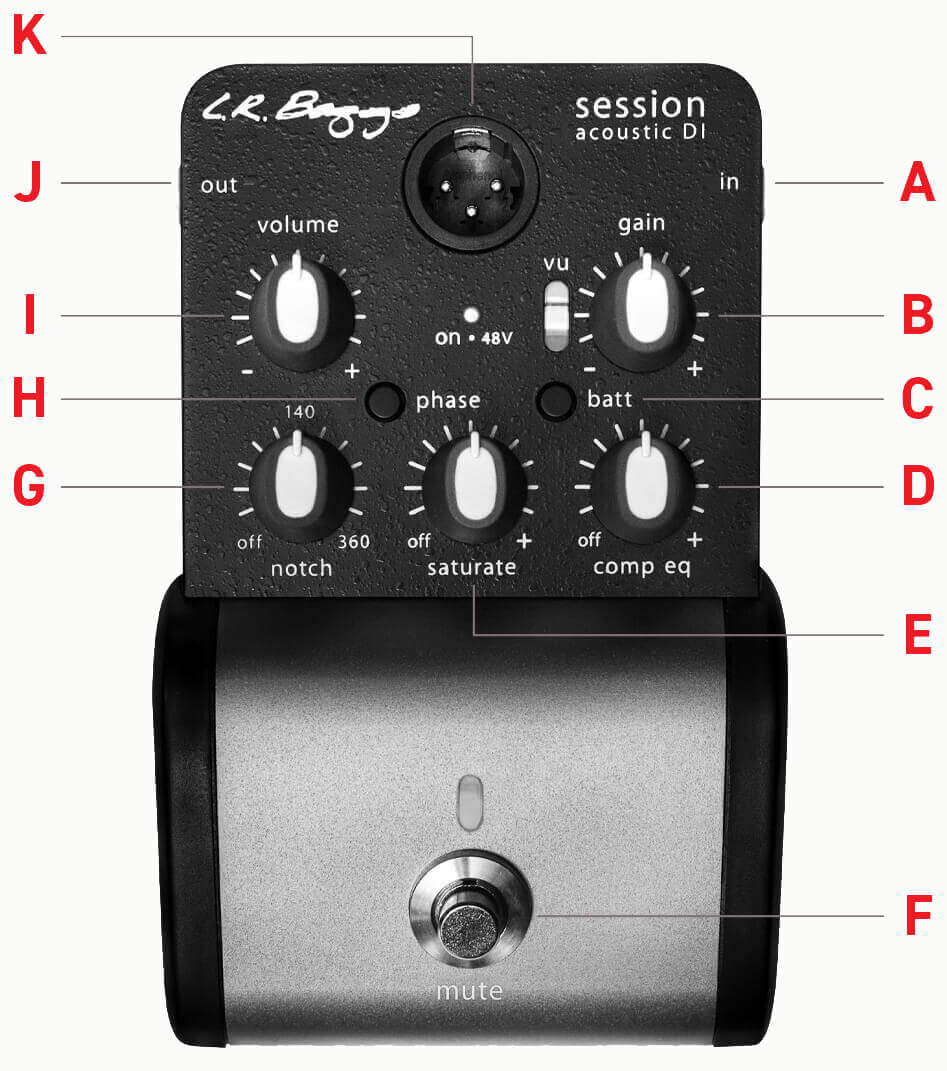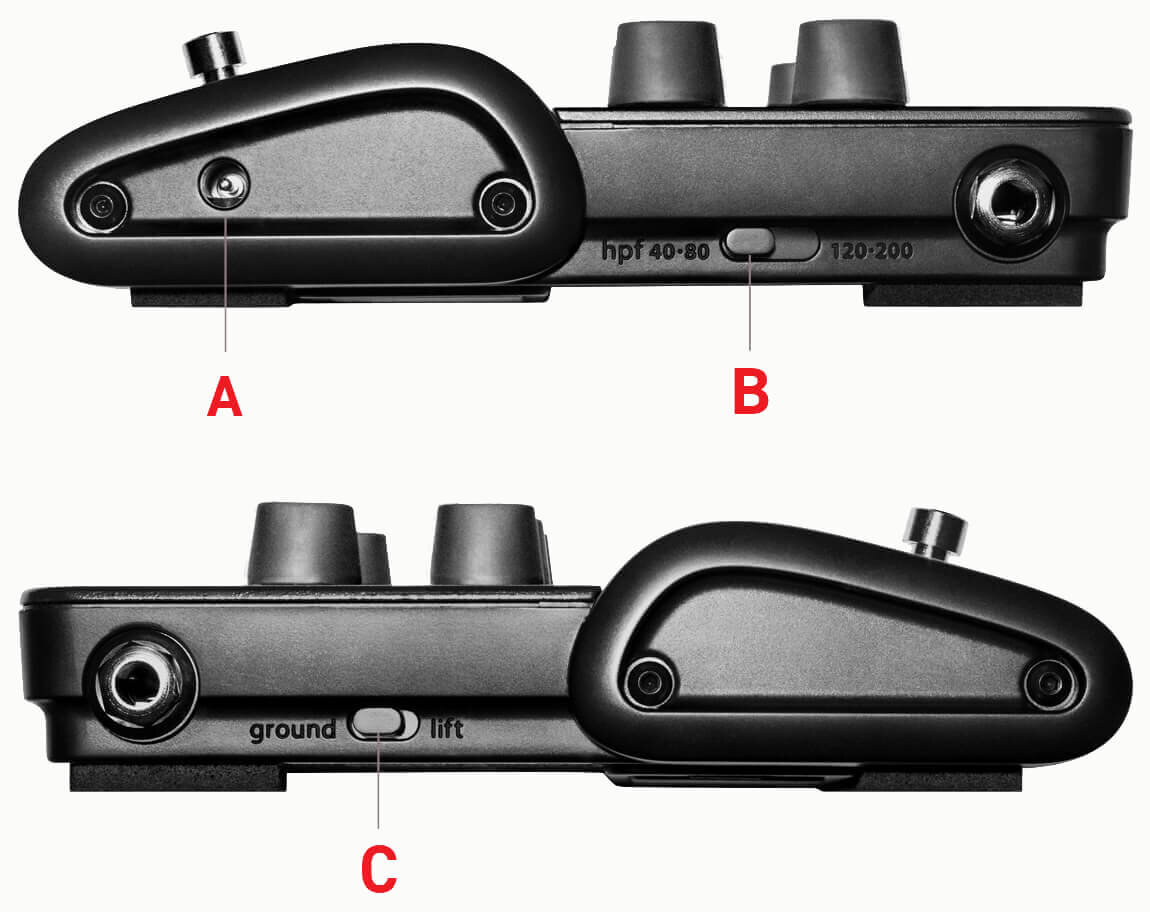Session DI
User’s Guide
Introduction
Inspired by the LR Baggs Handcrafted Video Sessions and our experience in some of Nashville’s great studios, Session Acoustic DI brings our signature studio sound to your live rig. The Session DI enhances your acoustic pickup and imparts the rich sonic character that you’d expect from an experienced audio engineer using some of the world’s finest studio gear. We’ve captured this studio magic and put it into a compact, easy-to-use DI that will transform your live sound.
Getting Started
Power the Session DI with a 9V battery, 9V DC power supply (not provided) or 48V phantom power. An orange light will indicate 9V battery or DC power and a green light will indicate 48V phantom power.
Plug your guitar into the input to activate the Session DI (upper right hand side) and a cable to either the ¼” output (upper left hand side) or the XLR output (on the top).
Adjust the gain control by using the VU meter. Read section B in this manual for setting your gain to the appropriate level.
Plug the ¼” and/or XLR output cable into your amp or PA and experiment with the Session DI.
Continue with this manual to learn more about its features.
Top Features
A. Instrument Input
The ¼” input is an unbalanced (mono), all discrete input. Plugging into the input will activate the Session DI, therefore, unplugging will turn the system off. Be sure to mute the signal before unplugging from the Session DI to avoid a loud pop.
B. Gain
Setting the gain is one of the most important keys to achieving optimum sound quality and signal-to-noise ratio. If you have a volume control on your guitar, make sure it is turned all the way up before setting the gain. Begin with the gain control in the counter-clockwise position. Turn the control clockwise as you strum the guitar until the VU meter flashes red slightly at your loudest playing level. If red flashes too frequently, the input is clipping and you may experience unwanted distortion. Best results are achieved when the yellow flashes consistently.
C. Battery Check
Push the “batt” button to check how much life is left in the battery. The VU meter’s LED display doubles as the battery check function by reversing the color orientation. A full battery will give you approximately 125 hours of playing time. Two LEDs means you have approximately 30 hours left. One red LED means it’s time to change the battery (located on the underside). To maximize battery life, make sure to unplug your instrument cable when you are not using the Session DI.
D. Comp EQ
The Session DI features 3 narrowly focused bands of compression for taming common problematic frequencies and enhancing the voice of your guitar. The low, mid, and high frequency compressors are essentially “touch-sensitive” EQs that respond in real-time to your dynamics. The harder you strum, the more they compress and vice versa. When the knob is in the counter-clockwise position, the effect is completely off. Turn the control clockwise and apply to taste.
E. Saturate
The Session DI’s analog saturation is voiced specifically for the acoustic guitar. Engage the effect to add warmth, dimension and pleasing harmonic content while smoothing your signal for an enhanced, post-processed mix. Turn the control clockwise to saturate the signal.
F. Mute
Press the footswitch to engage the mute for both the XLR and ¼” outputs. The orange LED will light up when the Session DI is muted. Press the footswitch again to un-mute your signal.
G. Notch
The notch filter is designed to help control feedback. If your guitar begins to feedback, slowly turn the notch control clockwise. The offending frequency will stop instantly when the notch is in the proper position.
H. Phase
Press this button to invert the phase. Usually, one phase will provide the best sound and feedback resistance. Phase is relative to your position on the stage so we recommend trying both phases each time you set up.
I. Volume
The master volume affects both the ¼” and XLR outputs.
J. ¼” output
The ¼” output is an unbalanced line level output. You can plug into any amp or device that has a ¼” input. For best results we recommend a full-range PA or high quality acoustic amplifier.
K. XLR output
The XLR, or DI output (located on the top), is a balanced output for connecting to a mixing desk with a standard XLR cable.
Side Features
A. DC INPUT
The DC power input is designed for a standard 2mm plug commonly used with effects pedals and “floor-box” products. Most power supplies or multi-power devices designed for musical products may be used. 9VDC recommended with a 12VDC maximum.
B. HPF (High Pass Filter)
The Session DI’s high-pass filter may be used to attenuate extraneous low frequencies, allowing for an appropriate mix in different playing situations and sound systems. The variable “hpf” switches between 40, 80, 120 and 200Hz.
C. Ground Lift
Engage this switch to reduce or eliminate ground loop related noise.
Limited Warranty
L.R. Baggs warrants to the using purchaser that this product shall be free of defects in workmanship and materials under normal and proper use for a period of one year. If you experience problems with this product, please contact your dealer.
Register your Session DI
Visit the Session DI Product Page
Specifications
1/4” INPUT
Input Impedance: 10 Megohms
Preamp Gain: -12dB to +26dB
Input Level: -25dBv to 1.8dBv (0.53Vrms to 1.23Vrms)
DI OUTPUT
Output Level: -1dBv (0.88VRms) Balanced
Output Impedance: 470 ohms
LINE OUTPUT
Output Level: -1dBv (0.88VRms) Unbalanced
Output Impedance: 470 ohms
POWER
DC Current Draw: 3mA
Power Supply: 9VDC with 100mA minimum
Voltage Range: 7.5VDC - 12VDC
9V Battery Life: 150 hours
Phantom Power: 48V
Signal to Noise: 90dB, unweighted
HIGH PASS FILTER
Frequencies: 40Hz, 80Hz, 120Hz, 200Hz
PHYSICAL CHARACTERISTICS
1.5Lbs, 6.25” Length x 4” Width x 1.75” Depth
Diese Spezifikationen können ohne vorherige Ankündigung geändert werden.


